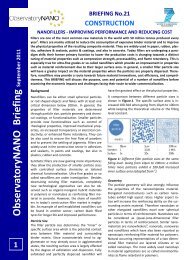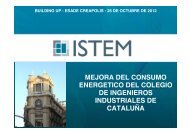Improving delivery of essential vitamins & minerals - Nanopinion
Improving delivery of essential vitamins & minerals - Nanopinion
Improving delivery of essential vitamins & minerals - Nanopinion
Create successful ePaper yourself
Turn your PDF publications into a flip-book with our unique Google optimized e-Paper software.
ObservatoryNANO Briefing July 20111BRIEFING No.18IMPROVING DELIVERY OF ESSENTIAL VITAMINS & MINERALSThe ChallengeThe large‐scale food production system <strong>of</strong> industrialisedcountries (and those which are in the transitionto industrialisation) has provided cheap andwidely available food stuffs, which is coupled tothe trend <strong>of</strong> increasing dependency on processedfood for growing populations. The reliance onprocessed foods is a complex combination <strong>of</strong> culture,trends, technology, and market. Neverthelesstoday processed foods form a large part <strong>of</strong> the diet<strong>of</strong> industrialised societies. It is recognised thatmany processed food stuffs <strong>of</strong>ten have reducedlevels <strong>of</strong> vital nutrients, through the processingprocedure itself, or through secondary effects <strong>of</strong>cultural tastes and fashions towards processedfoods high in salt, fat and sugar.Access to fresh produce is one approach, but availabilitymay be limited for some sections <strong>of</strong> society.Price is a also major issue, as has been seen in theearly days <strong>of</strong> organic foodstuffs.The challenge is to find solutions to provide thenecessary nutrients for a healthy lifestyle, whileproviding a sufficient and sustainable food source.Reduction <strong>of</strong> fats, sugars, cholesterol, and salt isone driver. The provision <strong>of</strong> <strong>essential</strong> nutrients(<strong>vitamins</strong>, <strong>minerals</strong>, fatty acids) is another. Indeed,an additional related driver relates to the increasinginterest in the development <strong>of</strong> fortified andfunctional foods (nutraceuticals) that can fight diseasessuch as obesity, heart disease, and a variety<strong>of</strong> cancers.The TechnologyBioavailability – why is it important?The term bioavailability refers to the fraction <strong>of</strong> asubstance that is actively available within thebody; for most oral doses this definition is interpretedas the fraction <strong>of</strong> the dose that enters thebloodstream 1,2 . Uptake (or intestinal absorption),AGRIFOODThe increase in global population is putting pressure on the food sector. Not only have recent naturaldisasters caused a price hike in food prices, we see country/continent specific shifts and needs. InEurope the increasing problem <strong>of</strong> obesity, and malnutrition, are <strong>of</strong> major concern . Here, cultural trendsare leading populations into high fat and high sugar diets with less emphasis on fresh fruit and vegetables,wholegrains, and a variety <strong>of</strong> protein rich and vitamin/mineral rich produce. These are not alwaysreadily available, and in some cases key nutrients are difficult to obtain and thus supplements are required.Alongside the need to promote a mixed diet and a healthier lifestyle, there are certain caseswhere nutrient supplements are required particularly in poorly soluble compounds. Encapsulation providesa promising approach, and R&D expectations point to a real contribution in increasing the bioavailability<strong>of</strong> nutrients. Moreover, novel processing techniques are indicating that inclusion into processedfoods themselves (so called fortified foods) is a means <strong>of</strong> including these supplements into the diet <strong>of</strong>the European citizen.on the other hand, refers to fraction <strong>of</strong> the dosethat is absorbed through the intestinal walls. Althoughboth definitions are related, the entiredose that is absorbed through the intestine(uptake) may not be bioavailable due to the variousprocesses involved in the absorption <strong>of</strong> nutrients.To design effective nanoparticle <strong>delivery</strong> systemsfor nutrients, nutraceuticals and related activeingredients, it is necessary to understand thebiological processes that regulate uptake andbioavailability.Which nutrients are the most pressing?There are a number <strong>of</strong> nutrients that have beenflagged as being important for health, to preventdisease and also to reduce the effects <strong>of</strong> ailments.Nutrients for which nanoencapsulation will provideadded value are those which are poorly soluble inwater (the medium in which nutrients are passedthrough the digestive system) include <strong>vitamins</strong>,anti‐oxidants, carotenoids, omega‐3 fatty acids,coenzyme Q10, curcumin, green tea polyphenols,and quercetin.What does a <strong>delivery</strong> system need to achieve?A nutrient <strong>delivery</strong> system must be able to:• Contain enough bioactive substance and efficientlyretain it during storage, processing, andtransport;• Prevent oxidation or other chemical degradation;• Be easily incorporated into food and drink withoutcausing a change in flavour, texture, or appearance;• Be produced by materials generally recognizedas safe (GRAS) and conform to good manufacturingpractices;• Show an appropriate cost/benefit ratio;• Depending on the nutrient, preferably show targeted<strong>delivery</strong> and controlled release (such asin specific areas <strong>of</strong> the body).All <strong>of</strong> these features should be achieved withoutinducing adverse effects.
AGRIFOOD: IMPROVING DELIVERY OF ESSENTIAL VITAMINS & MINERALSObservatoryNANO Briefing July 20112How does nano‐encapsulation help?With regard to nutritional supplements,nanotechnology has been long used to reduce theparticle size <strong>of</strong> various compounds for improvingtheir absorption. Among several approaches thathave proved to be very effective in creatingnanoparticles, the best way appears to be throughencapsulation. Molecules are separated and thenenveloped in the active compound. Suchcompounds are therefore immediately andeffectively absorbed in the body. There are a number<strong>of</strong> platforms available for this purpose, basedon natural and synthetic materials. Nanoemulsionsfabricated from food‐grade ingredients are beingincreasingly utilized in the food industry toencapsulate, protect, and deliver lipophilicfunctional components, such as biologically‐activelipids (omega‐3 fatty acids, conjugated linoleicacid) and oil‐soluble flavors, <strong>vitamins</strong>,preservatives, and nutraceuticals.Figure 1: Schematic representation <strong>of</strong> the core‐shellstructure <strong>of</strong> particles in nanoemulsions 3 .For example dibenzoylmethane nanoemulsions(derived from liquorice) have shown the potentialto enhance oral bioavailability threefold comparedto microemulsions 3 . Critical to this is the control <strong>of</strong>interfacial properties which control the stability <strong>of</strong>droplets (either water or oil) within the emulsion4,5 . Such systems must be robust enough towithstand food processing conditions, and environmentalchanges during distribution and handlingby the consumer. Finally, one <strong>of</strong> the main obstaclesto using nanoemulsions for foodstuffs is thelack <strong>of</strong> food‐grade surfactants 6 .There are several different compounds, both biogenicand synthetic which are being developed forthe purpose <strong>of</strong> delivering additional nutrientswithin food. Table 1 summarises the most promising<strong>of</strong> these.ImpactsEconomicGrowing health awareness, time constraints, andMaterial Description Potential applicationsNanoemulsions Made from a variety <strong>of</strong> lipids or otherpolymers, droplet size in the order <strong>of</strong>100 nm. Relatively stable systems.Delivery <strong>of</strong> both hydrophobic and hydrophiliccompounds. Possibility <strong>of</strong> multiplephases and hence simultaneous or sequential<strong>delivery</strong> <strong>of</strong> multiple compounds.Solid LipidNanoparticlesLiposomesMicellesCaseinCrystalline or semi‐crystalline stabilisedby a surfactant coating. Made by emulsiontechnologies. Stable system.Capsules consisting <strong>of</strong> lipid bi‐layer withaqueous interior. Generally phospholipids,such as phosphatidyl choline.Droplets <strong>of</strong> surfactants (lipids or biopolymers)in a liquid.Milk protein that self‐assembles intomicellar structures.Whey proteins Largely β‐lactoglobulin and α‐lactalbumin. Can form fibrils, hydrogels,and nanoparticles dependent on processingconditions. Resistant to stomachacid and enzymes.Chitosan Carbohydrate isolated from crustaceans.Muco‐adhesive, bio‐compatible, nontoxic.Forms nanocapsules and hydrogels.SilicaBio‐compatible and degradable. Can bemade highly nanoporous.Delivery <strong>of</strong> hydrophobic materials.Delivery <strong>of</strong> hydrophilic compounds.Delivery <strong>of</strong> hydrophobic compounds(normally).Delivery <strong>of</strong> <strong>minerals</strong>, proteins and <strong>vitamins</strong>.Delivery <strong>of</strong> various hydrophilic compoundsto the intestinal mucosa. Also can be usedto provide nanoscale structure to food (i.e.affect mouth feel).Delivery <strong>of</strong> different compounds to theoral (e.g. for taste) or to the intestinal mucosa,as part <strong>of</strong> a multi‐component andlayered system.Delivery <strong>of</strong> various hydrophilic nutrients tothe stomach.Table 1: Some promising nanostructured <strong>delivery</strong> systems for nutrients.
AGRIFOOD: IMPROVING DELIVERY OF ESSENTIAL VITAMINS & MINERALSObservatoryNANO Briefing July 20113the ensuing demand for functional and conveniencefoods has and will continue to drive growthand development <strong>of</strong> the food encapsulation market.A recent report 7 estimated that the food encapsulationmarket is projected to reach about€27.7 billion by the year 2015. Development andapplication <strong>of</strong> food‐grade nanoemulsions hasrecently increased because <strong>of</strong> the demand for aneffective systems to encapsulate, protect andrelease functional food components. Conventionaloil‐in‐water emulsions are currently the mostwidely used emulsion‐based <strong>delivery</strong> systems inmany industrial applications. The small size <strong>of</strong>droplets (r
AGRIFOOD: IMPROVING DELIVERY OF ESSENTIAL VITAMINS & MINERALSObservatoryNANO Briefing July 20114Other issues have also been raised by ethicists,such as the proliferation <strong>of</strong> nutritionallyengineeredfoods is deemed to contribute to atrend <strong>of</strong> nutrification. This means that the value <strong>of</strong>food is increasingly reduced to its nutritional contents11 .EHS Impacts and legislationWith regard to the exposure for consumers, thefate <strong>of</strong> the vectors that carry the encapsulatednutraceuticals is unclear, the short, and longer,term effects needs to be further explored. Knowledgeabout the toxicity <strong>of</strong> nano‐vectors as well astheir overall bioavailability throughout the body isstill relatively sparse. During manufacturing <strong>of</strong>nano‐structured <strong>delivery</strong> systems, workers maypotentially be exposed to nanomaterials. On disposalor after excretion out <strong>of</strong> the human body,exposure <strong>of</strong> surface water and soil is possible. Hazardand risk assessment <strong>of</strong> nanomaterials shouldbe completed on a case‐by case basis.EU Competitive PositionThere is a large market in Europe for providing lowfat/sugar options as part <strong>of</strong> the drive for greaterconvenience in food products. Many Europeancompanies are becoming involved, including sometraditional food production firms. For example, "LaMorella Nuts", a firm located in Spain which has ahistory in confectionary and nut ingredients, hasbeen involved in R&D in nanotechnology in relationto functional foods. Also, the Italian pasta firm“Antonio Amato” has invested time in encapsulationvia participation in the FP7 NANOFOODS project.In Israel, there are a number <strong>of</strong> companiesdealing in this area; “Nutralease” develops micellesthat can be used to encapsulate a variety <strong>of</strong> foodrelated substances, such as <strong>vitamins</strong>, aromas, etc.(www.nutralease.com). “Karmat Coating IndustriesLimited” has 20 years <strong>of</strong> microencapsulation experienceand has been active in exploring nanoencapsulationpossibilities. In Europe, one <strong>of</strong> the majorplayers is AQUANOVA, based in Germany, itprovides nano‐micelles for <strong>delivery</strong> <strong>of</strong> many types<strong>of</strong> nutraceuticals.Finding evidence <strong>of</strong> nano‐enabled nutraceuticalson the market is not easy. A number <strong>of</strong> productslabelled as “nano” are on the market already. “RBCLife” <strong>of</strong>fers a number <strong>of</strong> nanobased nutraceuticalssuch as its Nanoceuticals TM range (including Silver22 and Microhydrin®) or its Nanogreens(www.biopharmasci.com/supersorb) which usesencapsulation with liposomes.Another product labelled as “nano” are the “Nano‐Go Nutraceutical” products(www.canyonworldquest.com/press.html). What isdefined as nano, and what is the nano‐componenthere is unclear. However, these kinds <strong>of</strong> productsare illustrative <strong>of</strong> the vision within certain elements<strong>of</strong> industry with regards to nano‐enablednutraceuticals.Summary• Nanoencapsulation <strong>of</strong>fers tremendous potentialin providing a means to deliver difficult‐to‐attainnutrients in fortified food products.• Nutraceuticals which provide nutrients that havea clear therapeutic or disease prevention effectpromise to be better delivered and morebioavailable through nanoencapsulation• Consumers appreciate these potential benefits,whereas their concerns mainly occur aroundfood modification in general, and thus is not particularto nanotechnology, alongside this, theemphasis on modification/fortification <strong>of</strong> foodsmay distract resources from providing organic,fresh and unprocessed foods.• Legislation is the biggest barrier to commercialisationhere; it is difficult to provide guidelines forregulation and standards.• The lack <strong>of</strong> comprehensive knowledge <strong>of</strong> toxicity<strong>of</strong> nanomaterials is a broader issue, but becomesspecific in the case <strong>of</strong> encapsulation for foodstuffs precisely because the technology aims atincreasing bioavailability.• European research in this area is quite strong,and companies involved in nano and microencapsulationare visible. But without a clearerregulatory landscape, growth in this area and theexploitation <strong>of</strong> research findings in nanoencapsulationwill be considerably limited.Contact InformationTechnical: Eleanor O’Rourke, Institute <strong>of</strong>Nanotechnology, eleanor.orourke@nano.org.ukEconomic: Gabriela Salejova, TC ASCR,salejova@tc.czReferences1D.J. McClements, E.A. Decker, J.Weiss, Journal <strong>of</strong> Food Science 72(8),(2007) 109–1242H. Auweter, H. Haberkorn, W. Heckmann, D. Horn, E. Lüddecke, J.Rieger, H. Weiss, Angew. Chem. Int. Ed. 38(1999)15, 2188‐21913Huang Q. et al (2009), Journal <strong>of</strong> Food Science4C.P. Tan, M. Nakajima, Food Chemistry 92 (2005) 661–6715B.S. Chu, S. Ichikawa, S. Kanafusa, M. Nakajima,, J Am Oil Chem Soc(2007) 84:1053–10626Garti, N., Spernath, A., Aserin, A. & Lutz, R. (2005), S<strong>of</strong>t Materials, 1,206‐218.7“Food Encapsulation: A Global Strategic Business Report,” GlobalIndustry Analysts, Inc., San Jose, CA, July 2010.8http://www.foeeurope.org/activities/nanotechnology/Documents/Nano_food_report.pdf9http://www.euractiv.com/en/cap/novel‐foods‐review‐stumblescloning‐news‐50361010http://www.europarl.europa.eu/oeil/file.jsp?id=5583302





